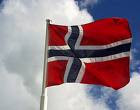Yes, it's a Fairy Tale...

illustration by: Theodor Severin Kittelsen
White - Bear - King - Valemon
from Norwegian Folk Tales, Norwegian Heritage book
Peter Christen Asbjørnsen and Jørgen Engebretsen Moe
Translated from the Norwegian by Pat Shaw
Heritage Book Series by
http://www.norwegian-heritage.no/Published by
http://www.fontforlag.com/Authors Asbjørnsen & Moe on Wikipedia...
http://en.wikipedia.org/wiki/Norwegian_FolktalesFolk Tale on Wikipedia...
http://en.wikipedia.org/wiki/White-Bear-King-ValemonSynopsis from Wikipedia...
A king had two ugly and mean daughters and one, the youngest, who was beautiful and gentle. She dreamed of a golden wreath. Her father set goldsmiths to make it, but none of them matched her dream. Then she saw a white bear in the woods, and it had the wreath. The bear would not give it to her before she agreed to go away with him, and got three days to prepare for the trip. The daughter did not care for anything as long as she had the wreath, and her father was glad of her happiness and thought he could keep off the bear, but when it came, it knocked his whole army about.
The king sent out his oldest daughter. The bear took her on its back and rushed off with her, but asked her if she had ever sat softer or seen clearer, and she said she had, on her mother's lap, and at her father's court; so the white bear brought her back to the castle. The next Thursday it came again, and the king tried his second daughter, and she also failed.
The third Thursday, the king had sent his third daughter, and she had never sat softer or seen clearer, so it took her to its castle. Every night, it turned into a man and came to her bed in the dark. Every year, she had a child, but as soon as the baby was born, the bear rushed away with it. At the end of three years, she asked to visit her parents. There, her mother gave her a candle so that she could see him. At night, she lit it and looked at him, and a drop of tallow fell on his forehead, waking him. He told her that if she had waited another month, he would have been free of a troll-hag's spell, but now he must go to her. He rushed off, but she seized his fur and rode him, though the branches battered her, until she was so tired that she fell off.
She searched in the forest until she came to a cottage where an old woman and a little girl were. The old woman told her that the bear had gone by; the little girl had a scissors that, whenever she cut in the air, silk and velvet appeared, but she said the woman had more need of it, and gave it to her. She went onto another hut, with another old woman and little girl. This time, the little girl gave her a flask that poured whatever was wished for and never emptied. She went onto a third hut, where the little girl gave her a cloth that could conjure up food.
The fourth night, she came to a hut where an old woman had many children who cried for food and had no clothing. The princess fed and clothed them, so the old woman had her husband, a smith, make her iron claws so she could climb the mountainside. With them, she reached a castle where the Troll-Hag was to marry the white bear. She started to clip out cloth. The Troll-Hag offered to trade for them; the princess insisted on a night with her sweetheart, and the troll-hag agreed but drugged him, so that she could not wake him. The next day, she bribed her way in with the flask; again the troll-hag had drugged him, but an artisan next door heard her and told the king. The third day, she bribed her way in with the cloth, and the king had not drunk the drink, and they could talk.
The king had them put a trap door in the bridge the bridal procession was to cross, and had it opened so that the troll-hag fell through it and died. They took her gold and went to his homeland for the real wedding, but on the way, they took the little girls, and the princess learned that they were her own daughters, whom the white bear had taken so they could aid her in her quest.
Note: The End, they live happily ever after (or so go most Fairy Tales told...)
A colored postcard of this illustration brought me to this Fairy Tale & then finally to a Book Shop where I found, in English, a Norwegian Folk Tales book with this illustration of the White Bear King Valemon on the cover...of course it doesn't hurt that I live in Stavanger, Norway either to find these things?!

The Nix (or water elf) as a (white) Brook Horse
Illustrated by Theodor Severin Kittelsen
More about Illustrator on Wikipedia...
http://en.wikipedia.org/wiki/Theodor_KittelsenMore about the Nix as a Brook Horse...
Bäckahästen (translated as the brook horse) is a mythological horse in Scandinavian folklore.
If properly approached, and if you brought the Nix a treat of three drops of blood, a black animal, some ... (Scandinavian vodka) or ... (wet snuff) dropped into the water, he would teach a musician to play so adeptly "that the trees dance and waterfalls stop at his music."
It has a close parallel in the Scottish kelpie.
It was often described as a majestic white horse that would appear near rivers, particularly during foggy weather.
Anyone who climbed onto its back would not be able to get off again.
The horse would then jump into the river, drowning the rider.
The brook horse could also be harnessed and made to plow, either because it was trying to trick a person or because the person had tricked the horse into it.
New World Encyclopedia link...
http://www.newworldencyclopedia.org/entry/Nix
















































